The Street Photographers Ideas
The Street Photographers Ideas
Blog Article
The smart Trick of Street Photographers That Nobody is Talking About
Table of ContentsStreet Photographers for DummiesThe Definitive Guide for Street PhotographersSome Known Details About Street Photographers Some Known Questions About Street Photographers.How Street Photographers can Save You Time, Stress, and Money.
Road digital photographers do not necessarily have a social purpose in mind, however they favor to separate and capture minutes which might or else go unnoticed.Though he was influenced by a lot of those that affected the street photographers of the 1950s and '60s, he was not primarily curious about recording the spirit of the road. The impulse to aesthetically record people in public started with 19th-century painters such as Edgar Degas, douard Manet, and Henri de Toulouse-Lautrec, who worked side by side with photographers trying to capture the significance of city life.
As a result of the comparatively primitive innovation offered to him and the lengthy exposure time needed, he had a hard time to catch the hustle and bustle of the Paris roads. He trying out a series of photo approaches, trying to find one that would enable him to record movement without a blur, and he found some success with the calotype, patented in 1841 by William Henry Fox Talbot. As opposed to Atget, digital photographer Charles Marville was hired by the city of Paris to produce an encyclopaedic file of Haussmann's city preparation project as it unravelled, hence old and new Paris. While the digital photographers' topic was basically the same, the outcomes were significantly various, showing the influence of the professional photographer's bent on the personality of the pictures he created.
Given the fine quality of his photographs and the breadth of material, engineers and musicians often purchased Atget's prints to use as reference for their very own job, though industrial rate of interests were barely his primary inspiration. Instead, he was driven to photograph every last remnant of the Paris he enjoyed.
The Single Strategy To Use For Street Photographers
They reveal the city via his eyes. His work and basic understanding of digital photography as an art type worked as ideas to generations of digital photographers that complied with. The following generation of street photographers, though they likely did not describe themselves therefore, was ushered in by the photojournalism of Hungarian-born photographer Andr Kertsz.
Unlike his peers, Brassa made use of a larger-format Voigtlnder video camera with a much longer exposure time, compeling him to be much more computed and thoughtful in his practice than he could have been if using a Leica. (It is assumed that he may not have actually had the ability to pay for a Leica back then, however he did, nonetheless, use one in the late 1950s to take colour photos.) Brassa's photographs of the Paris our website abyss illuminated by synthetic light were a revelation, and the compilation of the series that he released, (1933 ), was a significant success.
Cartier-Bresson was a champion of the Leica electronic camera and one of the very first digital photographers to maximize its capabilities. The Leica permitted the professional photographer to interact with the surroundings and to catch minutes as they took place. Its relatively little dimension additionally aided the photographer fade into the history, which was Cartier-Bresson's recommended strategy.
Facts About Street Photographers Revealed
It is due to the fact that of this essential understanding of the art of photo taking that he is commonly credited with finding the medium all over again about a century since its invention. He took pictures for greater than a half century and influenced generations of professional photographers to trust their eye and intuition in the moment.
These are the inquiries I will attempt to answer: And after that I'll leave you with my very own meaning of street digital photography. Yes, we do. Allow's begin with specifying what an interpretation is: According to (Street Photographers) it is: "The act of specifying, or of making something certain, distinct, or clear"
No, most definitely not. The term is both restricting and misdirecting. Seems like a street digital photography must be photos of a roads ideal?! And all street photographers, besides a little number of absolute newbies, will completely value that a street is not the vital element to street digital photography, and actually if it's a photo of a road with maybe a couple of dull individuals not doing anything of interest, that's not road photography that's a picture of a road.
What Does Street Photographers Do?
He makes a valid point do not you assume? While I concur with him I'm not certain "honest public photography" will catch on (although I do kind of like the term "candid photography") since "road digital photography" has actually been around for a lengthy time, with several masters' names attached to it, so I believe the term is right here to remain (Street Photographers).
Inside?! I hear you scream as you drink your hand to the skies. Why not? You can contend the beach, at an event, in a street, in a park, in a piazza, in a coffee shop, at a museum visit this page or art gallery, in a metro terminal, at an occasion, on a bridge, under a bridge ...

The Ultimate Guide To Street Photographers

Report this page